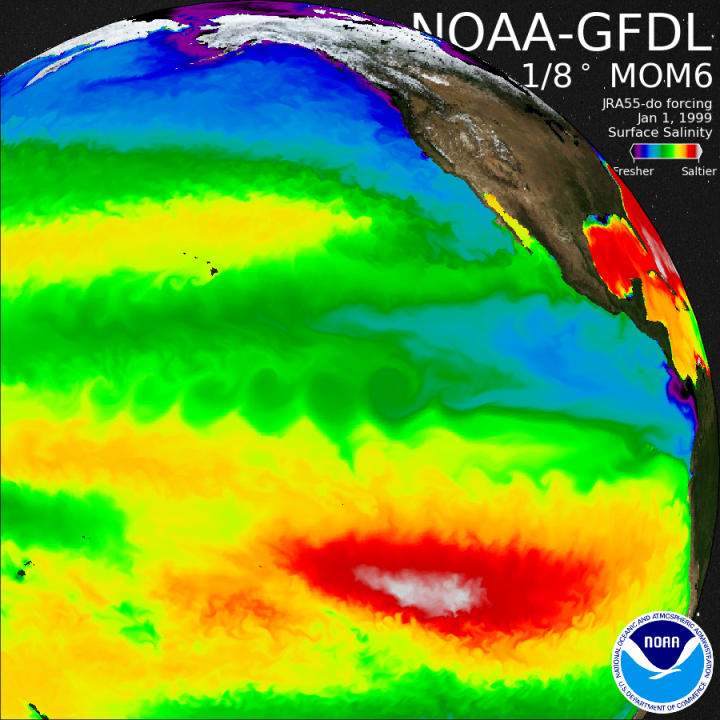Global mesoscale eddying ocean modeling
GFDL has a prominent history of mesoscale eddy-rich ocean and climate model activities, including the pioneering study of Southern Ocean mesoscale eddies by Hallberg and Gnanadesikan (2006) and the leading-edge coupled climate model studies using GFDL CM2.6 [e.g., Delworth et al (2012), Winton et al (2014), Griffies et al (2015), Dufour et al (2015, 2017), Morrison et al (2016), Saba et al (2016). CM2.6 has an ocean resolution of 1/10th degree, thus representing a vigorous mesoscale eddy field and offering unique opportunities for studying the role of ocean mesoscale eddies in regional and global climate.
The GFDL Oceans and Cryosphere Division focuses many of its research and development activities on questions related to the role of fine-scale boundary currents and transient ocean eddies for coupled air-sea interactions and the associated impact on climate variability and prediction. GFDL also focuses investigations on establishing mechanisms for the transport of heat to the base of ice shelves and the associated potential for sea-level rise. The Lab is developing the model tools and analysis methods to enable the pursuit of these questions using high-end mesoscale and submesoscale eddying climate models in tandem with regional process models.
GFDL envisions that its global climate models will make use of a grid resolution hierarchy that extends finer than the ¼-degree ocean/ice spacing of OM4, aiming towards the kilometer-scale spacing sufficient to represent dynamical processes adjacent to high latitude ice shelves. For this purpose, GFDL is presently developing a ⅛-degree configuration of MOM6 and SIS2 forced with the JRA55-do atmospheric state, and we envision further efforts with a 1/12-degree model afterward. In general, a grid resolution hierarchy offers a powerful science tool for addressing key science questions regarding the ocean’s role in climate, including transient eddies, boundary currents, coastal/shelf processes, and ice-shelf/ocean interactions. Development of these complex and state-of-the-science tools is an ongoing process involving scientists and engineers across GFDL and in collaboration with partner institutions (e.g., NCAR, NCEP, Rutgers University).
All CM2.6 papers
Research Highlights
- What Are the Finger-like Clouds in the Hurricane Inner-core Region?
- The driving of North American climate extremes by North Pacific stationary-transient wave interference
- Causes and multiyear predictability of the rapid acceleration of U.S. Southeast Sea level rise after 2010
- Crucial role of sea surface temperature warming patterns in near-term high-impact weather and climate projection
- Skillful seasonal prediction of wind energy resources in the contiguous United States
- The GFDL variable-resolution global chemistry-climate model for research at the nexus of US climate and air quality extremes
- Poleward intensification of midlatitude extreme winds under warmer climate
- Kilometer-scale global warming simulations and active sensors reveal changes in tropical deep convection
- Atmospheric rivers over eastern US affected by Pacific/North America pattern
- Regulating finescale resolved convection in high-resolution models for better hurricane track prediction
- Increases in extreme precipitation over the northeast United States using high-resolution climate model simulations





